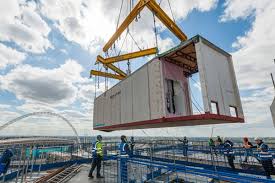Modular Construction

Modular construction is a modern building technique where structures are constructed off-site in factory-controlled settings using the same materials and standards as traditional construction. These modules or prefabricated units are then transported to the site and assembled like building blocks. This method has gained significant traction across residential, commercial, and even infrastructure projects due to its speed, efficiency, and reduced environmental impact.
One of the biggest trends driving modular construction is the increasing demand for affordable housing and rapid urban development. As cities grow and housing shortages become more critical, modular construction offers a faster and more cost-effective way to deliver homes, especially in areas where labor shortages or site constraints pose challenges to conventional methods. Additionally, governments and private developers are embracing this method for temporary or mobile structures such as healthcare units, schools, and disaster relief housing.
The use of modular construction is expanding into high-end and complex builds as well. Modern designs are no longer limited to basic box-like structures. Architects are now using modular techniques to create sophisticated and visually appealing buildings. Modular components are also being integrated into sustainable architecture, leveraging eco-friendly materials and efficient energy systems.
One of the main advantages of modular construction is speed. Since site preparation and module fabrication occur simultaneously, projects can be completed 30–50% faster than traditional builds. It also minimizes weather delays and offers greater quality control thanks to standardized manufacturing processes. Moreover, this method significantly reduces waste and site disruption, making it more environmentally friendly.
Cost-effectiveness is another strong benefit. Factory-based production lowers labor and material costs while reducing the potential for errors and delays. This makes modular construction especially attractive for developers seeking budget-friendly yet high-quality outcomes. Additionally, the flexibility in design and scalability of modules allows for easier expansion or modification in the future.
However, modular construction is not without its disadvantages. One major challenge is transportation. Moving large modules from factories to the construction site can be logistically complex and costly, especially in remote or densely populated areas. Furthermore, it requires precise coordination to ensure the modules fit perfectly during assembly.
Another drawback is limited customization once production begins. Changes to the design mid-process are often difficult or expensive to implement. Additionally, some local building codes and zoning regulations may not fully support modular construction, requiring extra effort to gain approvals and meet compliance standards.
Despite these challenges, modular construction is steadily reshaping the building industry with its promise of speed, efficiency, and sustainability. As technology improves and acceptance grows, it’s expected to become a dominant force in how we design and build the structures of tomorrow.
Ask ChatGPT